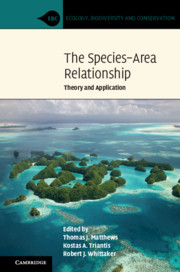Book contents
- The Species–Area Relationship
- Ecology, Biodiversity and Conservation
- The Species–Area Relationship
- Copyright page
- Contents
- Contributors
- Foreword
- Preface
- Part I Introduction and History
- Part II Diversity–Area Relationships: The Different Types and Underlying Factors
- 3 Explaining Variation in Island Species–Area Relationship (ISAR) Model Parameters between Different Archipelago Types: Expanding a Global Model of ISARs
- 4 Determinants of the Shape of Species–Area Curves
- 5 Functional and Phylogenetic Diversity–Area Relationships
- 6 Species–Area Relationships in Alien Species: Pattern and Process
- Part III Theoretical Advances in Species–Area Relationship Research
- Part IV The Species–Area Relationship in Applied Ecology
- Part V Future Directions in Species–Area Relationship Research
- Index
- References
3 - Explaining Variation in Island Species–Area Relationship (ISAR) Model Parameters between Different Archipelago Types: Expanding a Global Model of ISARs
from Part II - Diversity–Area Relationships: The Different Types and Underlying Factors
Published online by Cambridge University Press: 11 March 2021
- The Species–Area Relationship
- Ecology, Biodiversity and Conservation
- The Species–Area Relationship
- Copyright page
- Contents
- Contributors
- Foreword
- Preface
- Part I Introduction and History
- Part II Diversity–Area Relationships: The Different Types and Underlying Factors
- 3 Explaining Variation in Island Species–Area Relationship (ISAR) Model Parameters between Different Archipelago Types: Expanding a Global Model of ISARs
- 4 Determinants of the Shape of Species–Area Curves
- 5 Functional and Phylogenetic Diversity–Area Relationships
- 6 Species–Area Relationships in Alien Species: Pattern and Process
- Part III Theoretical Advances in Species–Area Relationship Research
- Part IV The Species–Area Relationship in Applied Ecology
- Part V Future Directions in Species–Area Relationship Research
- Index
- References
Summary
We build on the results of a recent paper that introduced a ‘global model of ISARs’; a structural equation model that provides a solid foundation for understanding ISAR variation across archipelagos. While revealing, the global ISAR model is incomplete, and here we pick on two issues for further scrutiny: (i) improved quantification of island isolation and configuration and (ii) addition of habitat islands. Including archipelago isolation metrics in our models, and adding in 65 habitat island datasets, we find our best models are similar to those presented in the previous study: a result that points to the robustness of the global model of ISARs. Overall, we find a negative relationship between ISAR intercept and slope as a function of archipelago species richness. Within our best models, archipelago isolation did not have an effect on ISAR model parameters. However, mean inter-island distance was found to be important in certain models. This finding suggests that intra-archipelago processes might be more important drivers of ISAR form than archipelago isolation. Unfortunately, the explanatory power of the best model based only on habitat island datasets was low, suggesting that we are some way from developing a predictive model for use in conservation applications.
Keywords
- Type
- Chapter
- Information
- The Species–Area RelationshipTheory and Application, pp. 51 - 77Publisher: Cambridge University PressPrint publication year: 2021
References
- 3
- Cited by

